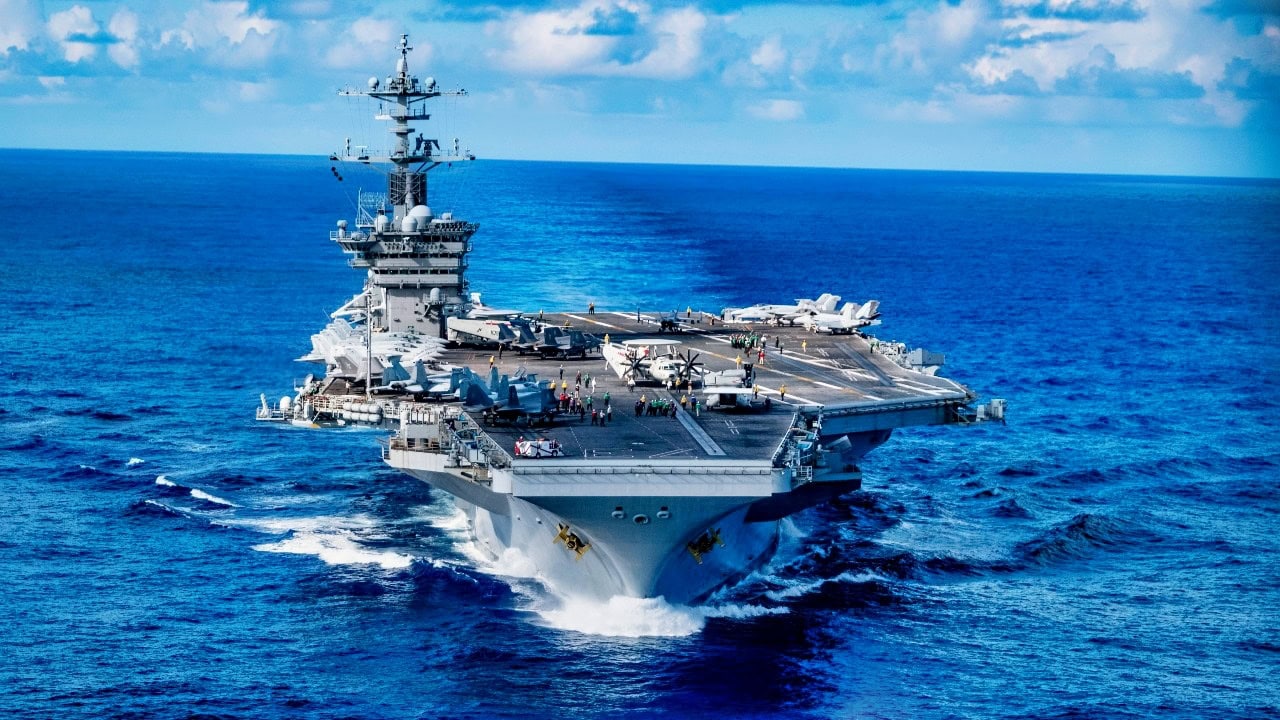Summary and Top Points: The USS George Washington recently completed an unprecedented six-year midlife overhaul, exposing serious challenges in maintaining America’s aging nuclear-powered carriers.
-Unexpected turbine damage, initially unnoticed, required complex, unplanned repairs.
-Typically, such overhauls last four years, but COVID-19 disruptions, budget constraints, and labor shortages significantly prolonged the process. Turbines, central to carrier propulsion and power generation, had never been intended for replacement, complicating matters further.
-This extended maintenance highlights potential vulnerabilities within the U.S. Navy’s carrier fleet, emphasizing the need for improved readiness and planning as these warships approach the end of their planned 50-year service lives.
USS George Washington’s Endless Overhaul: What Went Wrong?
Many questions have been raised about the extensive overhaul and reactor-refueling process (RCOH) of the USS George Washington (CVN 73), the sixth of the Nimitz-class carriers.
The process went on from 2017 to 2023, and the scrutiny was not so much about the procedures that were completed or whether they were necessary, but what the drawn-out procedure portends for the future of the carrier force.
The key point of inquiry is why the overhaul took more than 2,100 days to complete. The short answer is the standard maintenance and repair schedule was exacerbated by budgetary, labor, and COVID-19-related issues, thus the work took far longer than it normally would.
Last July, USNI News reported that the seemingly endless delays impacted the mid-life refueling and complex overhaul procedures for not one, but two of the nuclear-powered Nimitz-class aircraft carriers.
One of the reasons this particular overhaul ended up requiring more than 2,000 days of repair work was damage to the steam turbines that power the ship, according to USNI.
Unusual Damage to USS George Washington
According to Naval Sea Systems Command (NAVSEA), which handles most repair and maintenance for both the carriers and their nuclear power plants, significant damage was done to the generators aboard both the USS George Washington (CVN 73) and USS John C. Stennis (CVN 74).
Addressing the damage to these major components of the propulsion system “added unplanned work that was discovered after both carriers arrived at HII’s Newport News Shipbuilding for maintenance,” according to NAVSEA.
The Command’s official statement concerning the overhaul program reads that with each mid-life refueling and overhaul, “work package has planned inspections and routine refurbishment of the eight [turbine generators]; however, inspections for both George Washington and John C. Stennis revealed one generator on each ship with significant damage that resulted in unplanned growth work, which contributed to schedule extensions on both ships.”
Ordinarily, overhauls at the midlife point of Nimitz-class carriers require four years, but the Washington took almost six years, while the Stennis required five and a half, according to reports from last year. U.S. Navy Fiscal Year 2025 budget documents obtained by news organizations revealed that in 2024, the Navy estimated that work on the Stennis would require an additional 14 months, in order to complete the mid-life overhaul. This was entirely due to the complications on the turbine repairs.
Having to cope with the turbines onboard these carriers is no simple matter, and it turned out to be an issue that the overhaul yards were not well prepared to deal with.
Heart of the Ship’s Systems
The turbines are at the heart of a ship’s propulsion apparatus—they are the central onboard component of the power system. They are responsible for utilizing steam produced by the nuclear reactors and converting it into mechanical power to drive the aircraft carrier’s propellers.
The turbines also generate electrical power for the carrier’s onboard systems.
These turbines, originally installed on the ships more than 30 years ago, were designed to last the life of the carrier. Replacing them was therefore never part of the programmed set of tasks for the overhaul of the carrier and created a significant complication.
In addition to this unexpected task, the overhaul crew also discovered that the ship needed work that was not limited to major mechanical systems.
According to the reports on the maintenance regime, “the process involved upgrades to nearly every space and system on the ship.
“Tanks, the hull, shafting, propellers, rudders, piping, ventilation, electrical, combat and aviation support systems were repaired, upgraded and modernized. Work also included defueling and refueling the ship’s two nuclear reactors as well as repairs, maintenance, and upgrades to the propulsion plant.”
The process was beyond arduous. Rear Adm. James P. Downey, program executive officer for aircraft carriers, oversaw the later years of the George Washington’s extended 69-month RCOH process, and made this statement when the overhaul was finally complete:
“When USS George Washington completes her service life in 2048 or beyond, we know that many of the sailors who will serve on her final deployment have yet to be born. And yet we also know who they will be: They’ll be forged in the same shared legacy carried by these sailors today—and driven by the same love of country, of ship, and of the mission.”
About the Author: Reuben F. Johnson
Reuben F. Johnson is a survivor of the February 2022 Russian invasion of Ukraine and is now an Expert on Foreign Military Affairs with the Fundacja im. Kazimierza Pułaskiego in Warsaw. He has been a consultant to the Pentagon, several NATO governments and the Australian government in the fields of defense technology and weapon systems design. Over the past 30 years he has resided in and reported from Russia, Ukraine, Poland, Brazil, the People’s Republic of China and Australia.

